New CUMULUS MEDIA | Westwood One And Horizon Media Study: Why Artificial Fan Noise Increases Ad Receptivity At Live Sporting Events
In an unprecedented year, the sports industry has had to take creative steps to generate all of the excitement of a live game while battling the reality of empty stadiums due to COVID-19 restrictions. The solutions varied, from cardboard cutouts of fans to digital audiences and artificial fan noise.
To learn what sports fans thought about fan noise, as well as to ask about their other sports opinions in a year unlike any other, CUMULUS MEDIA | Westwood One and Horizon Media commissioned MARU/Matchbox to execute a study conducted in two waves.
The first wave focused on the likelihood and intention of sports fans tuning into fanless games and engaging in sports-related activities. It surveyed 1,060 people and was fielded between July 27, 2020 and August 10, 2020. The second wave, fielded November 17-24, surveyed 347 fans and examined response to the fall sports season and the shifting schedules of many leagues.
COVID-19 has not diminished the spirit of sports fans, especially those who listen on AM/FM radio
“Fans yearn to experience sports in person,” said Karen Van Vleet, Vice President, WHY at Horizon Media. “However, while the heart may be willing the head is saying ‘not so fast.’ As uncertainties over COVID continue, sports fans are leaning more into a variety of types of media and interests to meet their sports needs,” said Van Vleet.
“This new study reveals that AM/FM radio attracts the most engaged and active sports fans,” said Suzanne Grimes, EVP Marketing, CUMULUS MEDIA and President, Westwood One. “More than a third of heavy sports radio listeners said they actually listened to more sports despite the COVID related shifts in sports seasons and game schedules – that is 36% more than heavy TV sports viewers,” said Grimes.
“As one of largest buyers of sports media, it was essential for us to understand how our clients’ investments were being received and advise on how to best optimize these investments in these new environments,” said David Campanelli, EVP Chief Investment Officer at Horizon Media.
New Infographic: Bring the Noise: Understanding the Impact of Fan Noise on Sponsors and Advertisers
Click here to view or download the infographic designed by Horizon Media
Here are the key findings:
Ads tested in a fanless scenario, without supplemental fan or crowd noise, resulted in video ads feeling less informative than those within the supplemental fan noise environment
“Sports are about community and connection, so not seeing hearing their fellow and rival fans in the stadiums and arenas alters the experience. Supplemental fan noise helps restore the baseline, creating a richer experience by providing the buzz, cheers and atmosphere craved by fans,” said Van Vleet. “Since the quality of sports experience influences ad receptivity, the presence of fan noise or lack thereof can have a direct impact on a fan’s engagement with ads,” said Van Vleet.
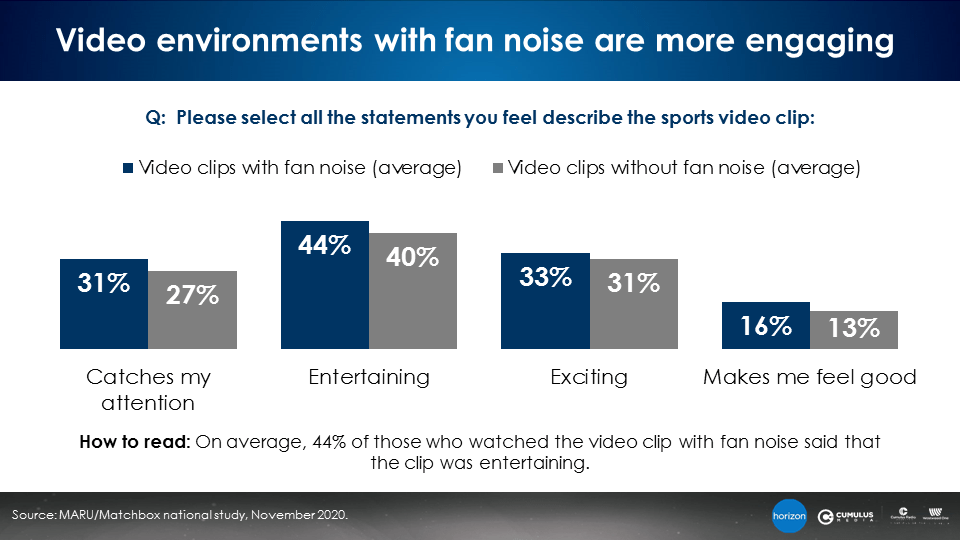
Compared to video environments without fan noise, sports fans said ads with fan noise were more likely to catch their attention, make them feel good, and be more entertaining and exciting.
Audio ads performed better in a broadcast with fan noise versus a fanless environment
Audio ads within a broadcast with fan noise were more likely to be perceived as helpful, relatable, authentic and informative.
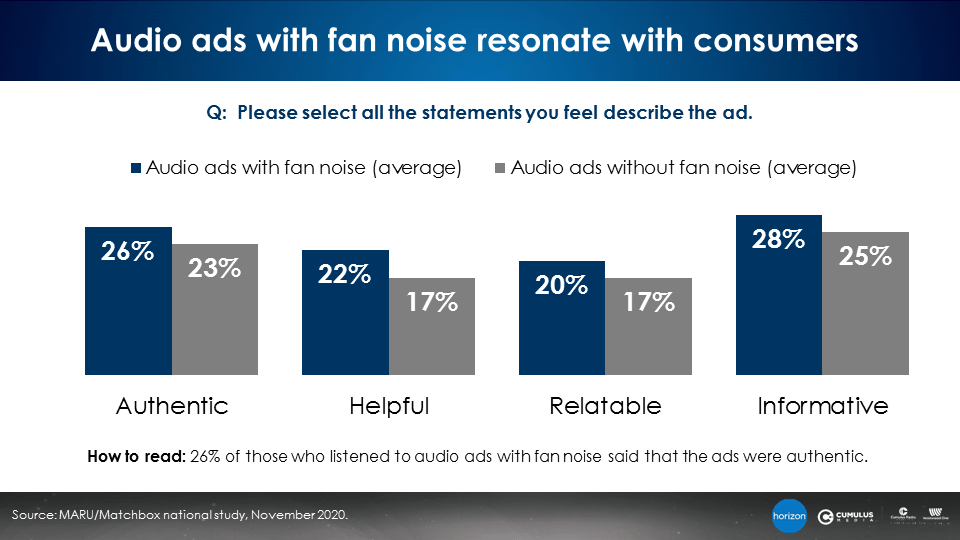
While supplemental fan noise may restore some of the feelings and sounds of normalcy, fans want a more participatory experience even if they can’t attend in person
More than 50% sports fans say they supported at least one of two augmented and virtual fan-engagement opportunities proposed. “While some sports saw a decline in their television viewing audience, the total sports viewership aggregated across sports has been similar to past years. However, there was more competition between the leagues and, given the schedule shifts, viewership was spread out making each individual sport’s rating dip,” said David Campanelli, EVP Chief Investment Officer at Horizon Media.
Two out of five sports fans said they would be likely to use an app that would control the crowd noise in the broadcast. (A “boo” button in the app would inject jeers into the broadcast. A clap icon would create applause for the broadcast.)
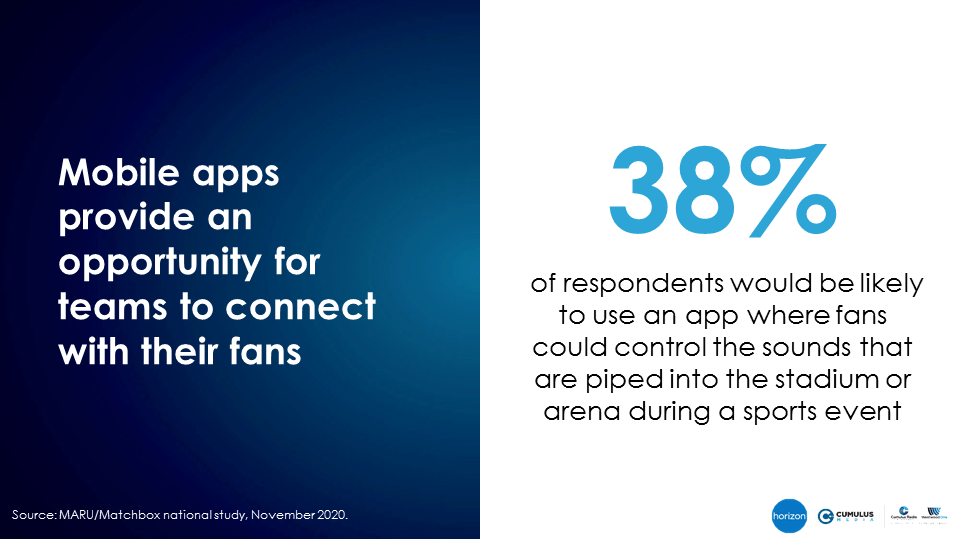
41% of fans said they would be likely to use a technology that would include a video of their facial reactions into the broadcast.
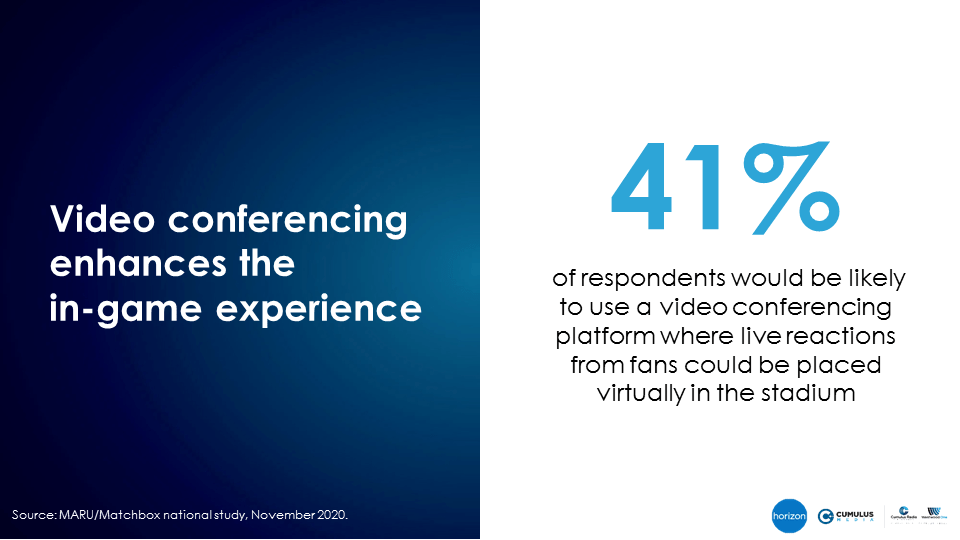
40% of fans say a big part of the game experience is the fans themselves – the chants, songs, and reactions
Despite scheduling changes, most sports fans continued tuning in to their usual sports, and younger fans were more likely to tap into new ones
41% of 18-34 sports fans said they listened/watched to new sports due to the shifting seasons.
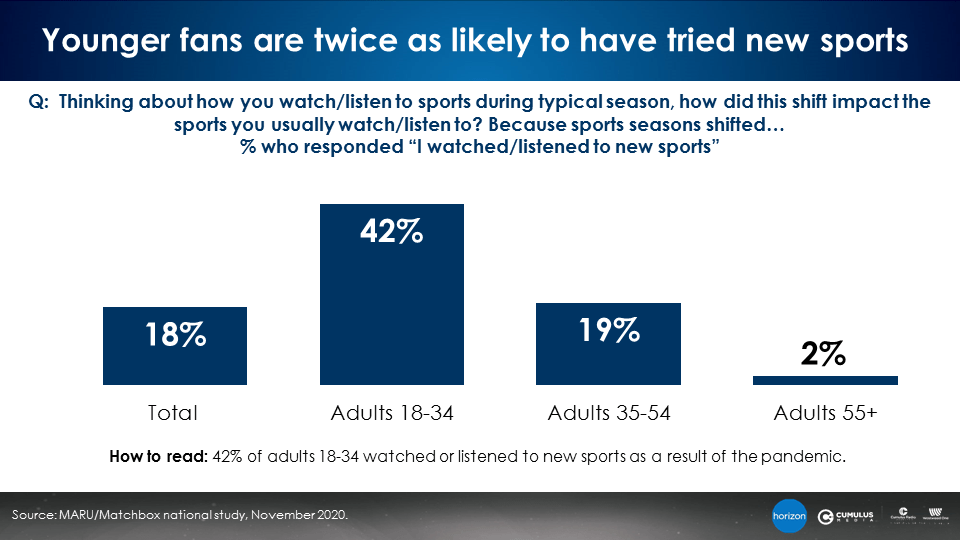
Versus heavy TV viewers, heavy AM/FM radio listeners were three times as likely to try new sports this fall
27% of heavy AM/FM radio listeners said they watched/listened to new sports due to shifting schedules. Only 9% of heavy TV viewers tried new sports.
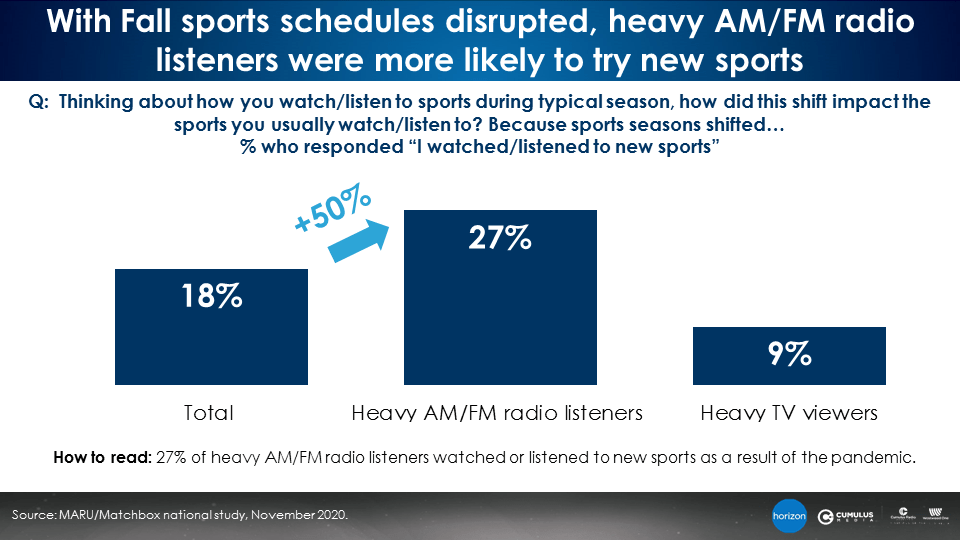
When asked why sports audiences were somewhat lower this Fall, fans theorized that it was due to COVID-19, fanless games, sports season changes, politics and social justice in sports, and a lower priority for sports overall
To recap:
- COVID-19 has not diminished the spirit of sports fans, especially those who listen on AM/FM radio
- Ads tested in a fanless scenario, without supplemental fan or crowd noise, resulted in video ads feeling less informative than those within the supplemental fan noise environment
- Audio ads performed better in a broadcast with fan noise versus a fanless environment
- While supplemental fan noise may restore some of the feelings and sounds of normalcy, fans want a more participatory experience even if they can’t attend in person
- 40% of fans say a big part of the game experience is the fans themselves – the chants, songs, and reactions
- Despite scheduling changes, most sports fans continued tuning in to their usual sports, and younger fans were more likely to tap into new ones
- Versus heavy TV viewers, heavy AM/FM radio listeners were three times as likely to try new sports this fall
- When asked why sports audiences were somewhat lower this Fall, fans theorized that it was due to COVID-19, fanless games, sports season changes, politics and social justice in sports, and a lower priority for sports overall
Pierre Bouvard is Chief Insights Officer at CUMULUS MEDIA | Westwood One.
Contact the Insights team at CorpMarketing@westwoodone.com.